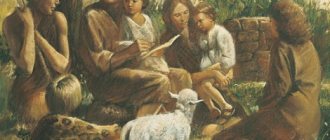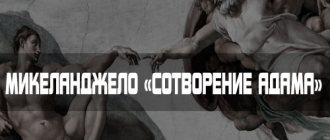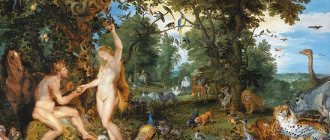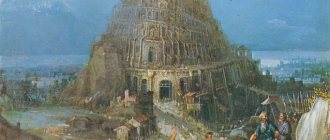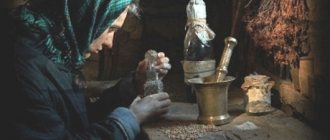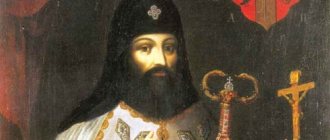After the creation of the world, God created the first people - Adam and Eve
After the creation of the world, God created the first people - Adam and Eve. They lived in paradise, God allowed them to live as they wanted, eat, drink, live in peace and quiet.
But there was only one prohibition, God forbade them to eat the fruits of only one tree.
One day Eve was tempted by the devil, and she disobeyed the commands of God and ate fruit from the very tree from which it was forbidden to eat fruit. After which she gave this fruit to Adam, and he also tasted it.
Adam and Eve in Paradise. Over time, they had two sons - Cain and Abel
Then the first fall of people took place. God expelled Adam and Eve from paradise because they disobeyed His commands.
He expelled them from paradise, and Adam and Eve began to live on earth. They cultivated the land, engaged in livestock farming and other labor, hoping that God would forgive them and return them to the Kingdom of Heaven.
After the Fall, God expelled Adam and Eve from paradise and they began to live on earth
Over time, they had two sons - Cain and Abel. Abel and his brother Cain, just like their parents, tried to please God in everything and lived according to God’s commandments.
Abel was engaged in cattle breeding, and Cain grew plants. They very often brought their sacrifices to God, trying to appease and receive mercy.
Cain lit a fire, throwing fresh ears of corn into it, taken from his harvest, and Abel sacrificed a lamb to God. The Lord saw that Abel made a sincere sacrifice, but Cain did not.
Therefore, God accepted a sincere sacrifice, but ignored Cain’s sacrifice.
Cain and Abel make a sacrifice to God. Cain lit a fire, throwing fresh ears of corn into it, taken from his harvest, and Abel sacrificed a lamb to God
Then Cain became very angry with his brother. Every day he hated Abel more and more, anger grew more and more in his heart.
Then Cain killed Abel, calling him to the field with him.
When the Lord saw this, he asked Cain where his brother was. And he answered him that he did not know. Any murder is a sin, and shedding the blood of a loved one is doubly bloody.
Cain lost his mind so much that the thought of killing his loved one, his brother, arose in his head.
Consequences of Sin [↑]
After sin, the Almighty reduced Adam's height to one hundred amot
(about 50 meters) (
Sanhedrin 38b; Bava Batra 75a; Bereshit Rabbah 12:6
).
According to another version, according to which Adam was simply a tall man, but not a giant, his wisdom was “diminished” due to sin ( Shiurim behaqadot chazal, Chagigah 12a
).
Due to the sin committed by the first man, the opportunity for a different development of history was missed. Adam was originally worthy to have the Torah transmitted to humanity through him. But when he sinned, the Almighty said: “If he could not resist even for one hour the prohibition that I commanded him, then how will I give him 613 commandments?!” ( Bereshit Rabbah 24:5; Seder Hadorot
).
But if Adam had survived the test with the Tree of Knowledge, the world would have immediately reached the final point of development: both he and his descendants would have been awarded eternal life in the Garden of Eden ( Zohar 1, 61a; Kitvei Arizal, Tehillim 79
).
On the twelfth and last hour of that day, the Creator decided to expel Adam from the Garden of Eden ( Sanhedrin 38b
).
After all, since the first man still did not repent of his sin, he could “stretch out his hand to the Tree of Life” ( Genesis 3:22
), the fruits of which impart immortality, and then the death sentence would be unenforceable (
Genesis Rabbah 21:6; Ramban, Bereshit 3:22
).
But the first Shabbat of the Universe had already arrived, and the exile was postponed for one day. And all Saturday night the sky over the Garden of Eden was illuminated by the primordial light, which shone only in the first seven days of the Universe ( Pirkei derabi Eliezer 19; Bereshit Rabbah 12:6
).
At the end of Shabbat, the Creator expelled Adam from the garden ( Genesis 3:23-24
).
At the same time, the Almighty replaced the light shell of the body of Adam and his wife with a covering of skin ( Zohar 3, 261b
), and the radiance surrounding Adam’s face also disappeared (
Bereishit Rabba 12:6, 16:1, Etz Yosef
).
They were banished to Mount Moriah
, since the gates of the Garden of Eden are located near it (
Pirkei derabi Eliezer 20; Shocher tov 92
).
When Adam saw that complete darkness was coming, he was afraid and said: “Woe is me! This is because I have sinned!” He did not yet know that this was the order established on earth. But then he found two flint stones and, striking one against the other, managed to light a fire. Adam said the blessing: “ ...Bore Meorei Aesh
(Blessed are You, O Lord, our G-d, Ruler of the Universe, who created the light of fire" (
Avoda zara 8a; Bereshit Rabbah 11:2, 12:6; Shocher tov 92
) - and this is where the custom of blessing the light of fire comes from as a sign of the separation of Shabbat from everyday life (
Yerushalmi, Berachot 8:5
).
Adam and his wife fasted and wept all night. Moriah on Mount
altar, sacrificed an ox to Him (
Avoda zara 8a
).
From that day on, Adam fasted for seven weeks, begging the Almighty to accept his repentance. And he was forgiven ( Pirkei derabi Eliezer 20
).
During the days of repentance, Adam selected a burial cave for himself at the very entrance to the Garden of Eden, south of Mount Moriah (now the Hebron region) and deepened it ( Pirkei derabi Eliezer 20; Zohar 1, 57b
).
And subsequently, for one hundred and thirty years, he remained in fasting and repentance, abstaining from intimacy with his wife ( Eruvin 18b
).
Adam hoped to atone for the death sentence imposed on him and his descendants. But it was impossible to correct what he had done even with complete repentance, because his sin had already led to irreversible changes in the spiritual state of the Universe ( Mikhtav meEliyahu 2, p. 85
).
In Syria is the famous tomb of Abel and other Old Testament people
For this sin, the Lord banished Cain to a foreign land, where he lived the rest of his days.
There is such a city on earth - Hebron, in Syria, where Old Testament people are buried. The Bible makes no mention of where Adam and Eve, Abel, the son of Adam and Eve, and many others were buried.
1599
Abel's grave was built this year
The famous tomb of Abel is located in Syria. It is located in the Shiite Muslim mosque of Nabi Habil.
It was built in 1599 and is located in the Ez-Zabadani region, about 50 kilometers from Damascus. In the mosque itself there is a grave with a sarcophagus, in which, according to legend, is the Old Testament Abel, killed by his brother.
What is surprising is that the length of Abel's grave is about 7 meters.
The length of Abel's tomb is about 7 meters
And the tombstone itself is made of a granite structure 5 meters long. But according to scripture, Abel was still a youth, and possibly a child.
And according to scientists, Abel’s height at the time of death was 5 meters, with a body weight of 1.5 tons. Adam, Abel's father, was 11 meters tall and weighed 3.5 tons.
In the photo you can see how big Abel’s tomb is
Many people ask whether the first people were really buried in these places, and were they really so gigantic?
The answer is quite simple, no one can prove it until the grave is opened. But the Syrian authorities simply will not allow this, because they consider these places to be holy.
The city of Damascus is translated as “Brother’s Blood,” so it is possible to assume that it was there that Abel was killed by his brother Cain.
On the side wall of Abel's tombstone there are several holes from which an amazing fragrant aroma emanates. It is believed that this is the smell of God's grace.
On the side wall of Abel's tombstone there are several holes from which an amazing fragrant aroma emanates
The following program tells about the unusual growth of Abel and about the giants who lived in Old Testament times.
There are 2 graves of Abel’s brother Cain on Earth
Is there a grave of Cain, Abel's brother? Recall that Cain was crushed by stones when his own house collapsed on him.
But Saint Dmitry of Rostov has a different version of what happened to Cain. His story says that Cain was killed by his great-grandson Lamech.
While Cain was sleeping calmly and peacefully in the bushes, his great-grandson was hunting. Lamech was a little blind, and he saw something moving in the bushes. There was a boy with him who helped him in the hunt, and he aimed Lamech at the very trembling bush where Cain slept.
As a result, Cain was killed by Lamech. Seeing this, Lamech became angry and killed the servant boy. So on earth, it turns out, there are two graves of Cain.
One of Cain's graves is located in the city of Shamsan, and the other in Kabul.
The two graves of Cain are owned by Muslims.
Adam and Eve, according to the Bible, also had a third son - Seth. Arabs believe that this character from the Bible is buried in Saudi Arabia, on Mount Abu Qubais. Next to it is another mountain on which the first people Adam and Eve and their son Seth are buried.
Are there any graves of the very first people, Adam Eve? Eve, the first woman on earth, also has two graves. It was believed that Eve outlived Adam by 10 years, although this fact is not stated anywhere.
Her tomb is 130 meters long, at the head is a marble slab with Arabic inscriptions, and there is a date palm growing on it, and some bushes growing at the feet. This is what those who have been to these places say.
Two rooms were built above the middle of the grave. A mosque was built in one, and a tomb in the other, where pilgrims come to worship. They say that Eve's grave is surrounded by a cemetery.
The grave of Eve, the mother of Abel, is located near the city of Jeddah, Saudi Arabia.
One day, one person, the sheriff of Mecca in 1882 tried to demolish Eve’s tomb, saying that people had gone crazy, and that a person, although he had lived on this earth for a very long time, could not have been 130 meters tall.
Much ado about nothing
— Do biblical archaeologists often make mistakes in general?
— Errors in scientific activity are inevitable, and moreover, they are even strategically useful, since their discovery leads not only to a revision of some specific views, but also to a deeper understanding of the problem.
Errors can be divided into two groups. Firstly, these are errors associated with incorrect interpretation of the text of Holy Scripture, and secondly, errors of an archaeological order: incorrect descriptions of artifacts, incorrect dating of what was found, and so on.
Priests at the excavations - Priest Alexander Timofeev (right), Archpriest Georgy Urbanovich, rector of the Smolensk Seminary (left), and Abbot Moses (Pilatz), rector of the monastery in Alapaevsk (top)
Here is an example of an error of both the first and second types. The famous Israeli archaeologist Yigal Yadin conducted many years of excavations in Megiddo, Hazor and Gezer and found the remains of multi-chamber gates everywhere. Before him, it was believed that in Gezer, for example, this was not a gate, but the remains of a tower. Yadin proved that these were the entrance gates of the city and unambiguously correlated them with the royal cities mentioned in the 3rd book of Kings, which Solomon built. He suggested that all these gates date back to the 10th century BC. But further research showed that all these gates were erected at different times. In Hazor, it is really the 10th century, in the rest - later. Yadin's scientific opponents even stated that there was no unified kingdom of David and Solomon at all. Yadin's mistake was that he so clearly connected the gate he found with the gate mentioned in the book of Kings. But the Holy Scriptures do not say at all that Solomon made this gate royal. They could have been built later, they could have been rebuilt many times. Yadin's mistake stems from an insufficiently accurate interpretation of the text of the Holy Scriptures and insufficient (and this is quite natural for his time) possibilities for accurate dating.
— The example you gave is still a particularity. Were there such serious, “systemic” errors that it was time to doubt the reliability of the results of biblical archeology and the authenticity of the biblical narrative?
— There were no such mistakes. On the contrary, a whole series of discoveries convinces us of the authenticity of Holy Scripture. Biblical criticism of the 19th century, when it was believed that the Gospels were written at the end of the 2nd century by people who could not see Jesus, has become a hopeless past. Or that the history of the Old Testament was written after the captivity in the Hellenistic period. Now any archaeological scientist, regardless of personal attitude to religion, will confirm that the Gospel is a product of the era of the first century, that the first Gospels (Matthew, Mark, Luke) were written even before the destruction of the Jerusalem temple in 70 AD .that the authors actually lived in Jerusalem. This follows from many details, sometimes even reservations in the text.
— Do biblical archaeologists have to deal with fake artifacts?
- Yes, from time to time it happens. Forgeries began at the dawn of biblical archeology, in the 19th century. The most famous forger of that time was Moses Shapiro. He made and sold not even individual fakes, but a whole complex of artifacts. These artifacts were bought by famous museums around the world - today Shapiro’s handicrafts can be found in the British Museum, the Louvre, and the Hermitage. I myself had to hold these fakes in my hands. For example, he cut off a part from an ancient scroll and put new inscriptions on it. As a result, Shapiro was exposed by the famous scientist C. Clermont-Ganneau, he was threatened with judicial investigation and he committed suicide.
But it is not always possible to clearly identify a fake. For example, in 1997, an Israeli collector presented to the scientific community an ossuary with the inscription “James, son of Joseph, brother of Jesus.” An ossuary is a box where bones were placed after the body had decayed. The ossuary itself is undoubtedly authentic, but there is some debate about the inscription. There was an uproar and there was a colossal trial. As a result, a decision was made: the court does not have data either for or against the signature. Therefore, the accused are free. But the question of authenticity still remains open.
Jerusalem was destroyed several times. And so there are historical difficulties in reconstructing houses and buildings from the time of Christ. The first destruction occurred in 70, when the Romans literally left no stone unturned. After this, several more cataclysms followed: the construction of the Roman city of Aelia Capitolina, the capture by the Persians in 614, then reconstruction by the Arabs and crusaders...
— How can ordinary people, non-specialists, perceive regular sensations on the topic of archaeological finds that supposedly overturn all our ideas about the Bible?
- You need to be extremely careful. First of all, you need to understand that journalists, as a rule, are not very educated people and therefore can be sincerely mistaken, considering something a sensation. Here is an example - a recent discovery that caused a lot of noise, the “gospel” of Judas. This is not a forgery, this is truly an ancient text - but a text created by the Gnostics in the 2nd century AD. Moreover, this text has long been known to the Church; the Hieromartyr Irenaeus of Lyons mentions it when he describes various Gnostic sects. The discovery of the “gospel” of Judas even benefited science: it became clear that the Gnostics were developing their own religion, completely different from either Judaism or Christianity. From Christianity there was only terminology. In a word, this text did not change anything, it was known, but when the Gnostics died out, it was forgotten.
But there are also obvious fakes; their creators strive only for fame and money. The press begins to promote such fakes.
Here's something else you need to understand: no serious researcher will ever contact the yellow press. Even if he is in conflict with official science, even if he believes that he is being erased, his discoveries are not recognized, he still will not get involved with the tabloids. Therefore, if you read in the yellow press about a sensational discovery and see links to scientists allegedly confirming it, do not believe it. There must be some kind of fraud here.
In addition, take into account the fact that archeology is a slow science. From the discovery to its correct interpretation, many years, or even decades, often pass. Therefore, if they tell you that something has just been discovered, and this something is such and such (for example, the ring of King Solomon or the Gospel of Pontius Pilate, or the skull of Adam) - doubt it. Such a quick interpretation is simply impossible.
In the Cave of the Patriarchs in Hebron is the tomb of Abraham, his wife and sons
Another grave of Eve is located in Hebron in the Cave of the Patriarchs. According to the Bible (Genesis 23, 49:29-32, 50:13) in this place there are the graves of Abraham, Isaac, Jacob, as well as their wives. Abraham is the ancestor of many nations, Isaac and Jacob are his children.
Abraham did not have children until he was 75 years old, but then the Lord sent three Angels to him, who informed him that he would have a son.
In the Cave of the Patriarchs in Kherson there are the graves of Abraham and his wife Sarah. Eve's second grave is also located here.
The places where Adam and Eve and many others are buried are revered not only by Muslims, but also by Christians. They also claim that the mosque in Iraq was built on the grave of Adam and righteous Noah.
Christians have their own legend about Adam's grave. According to legend, he died in 930, after which people no longer lived that long. Eve lived 10 years longer, that is, 940 years.
Adam died peacefully, calmly, and said goodbye to everyone before his death. He commanded all his grandchildren and children to pray to God.
According to legend, he died on Friday at six o'clock in the afternoon. All the people mourned his death greatly. According to European legend, he was buried in Israel, in Hebron. A huge oak tree grew at this place, on which three Angels later appeared to Abraham, informing him of the birth of a child.
Creation of the first man [↑]
As already stated above, Adam and his wife Chava (Eve) were created by the Almighty on the sixth day of Creation, on Rosh Hashanah - the first day of the month of Tishrei ( Bereishit 1:27, 31; Rosh Hashanah 10b; Zohar 1, 37a
).
Both day (daylight hours) and night (dark time of day) contain 12 hours. At the third hour of that day, the Almighty “made man from the dust of the earth” ( Genesis 2:7
), forming the corresponding organs, cavities and limbs (
Sanhedrin 38b; Seder Hadorot
).
And at the fourth hour the Creator “breathed into his nostrils a life-giving soul, and the man came to life” ( Genesis 2:7; Sanhedrin 38b
).
Adam's body was "made" from the same natural elements as the bodies of animals. Therefore, it is similar to them in the structure of its organs. But the supreme soul ( neshama
), thanks to which a person acquired thinking and speech, akin to the inhabitants of the higher worlds, who do not have a material body and are not subject to death (Ramban
, Bereshit 1:26
).
The supreme soul contained the fundamental essence of man, and it is to it that the word “created” ( bara
) and the expression “in His image” refer (
Genesis 1:27
).
But the body is called only “the flesh of man,” and not “man” himself (Vilna Gaon , Aderet Eliyahu 1:27
).
Adam was created on Mount Moriah
, on the site where the Temple of Jerusalem was subsequently built (
Pirkei derabi Eliezer 11:20
).
He was born adult (as a twenty-year-old) ( Bereshit Rabbah 14:7
) and circumcised (
Avot Derabi Nathan 2:5
).
His skin consisted of “subtle matter” like light, and his face radiated radiance (Zohar 1, 36b, 3:261b; Etz Yosef, Bereshit Rabbah 8:10
).
The body of the first man was huge: when he lay down, his head was far in the east of the earth, and his legs reached the extreme west ( Sanhedrin 38b, Rashi
).
Some commentators believe that the Talmud's indications that Adam was tall "from earth to heaven" and "from one end of the world to the other" ( Chagigah 12a
) are only figurative comparisons, just as the Torah says: "Great cities and strength to the heavens" (
Deuteronomy 1:28
).
He was simply very tall by human standards ( Yad Rama, Sanhedrin 38b
).
And there are interpreters who attribute the instructions of the Talmud not to growth at all, but to the wisdom that the Creator endowed Adam with: the comprehension of the first man covered everything “from earth to heaven” and “from one end of the world to the other” ( Shiurim be'agadot chazal, Chagiga 12a
).
Having created Adam, the Almighty showed him all the people who had yet to come into the world before the era of the resurrection of the dead: “every generation and its leaders, every generation and its wise men, every generation and its prophets” ( Bereishit Rabbah 24:2, Etz Yosef; Shocher tov 139
).
Adam was especially happy when he reached the time of Rabbi Akiva: he was delighted with the wisdom and righteousness of this man. But then he was struck by his martyrdom ( Sanhedrin 38b
).
At the fifth hour of the day Adam “rose to his feet” - and his head went high into the heavens ( Sanhedrin 38b
, Rashi).
When all other creatures saw man created “in the image of G‑d” ( Bereishit 1:27
), they decided that this was their Creator and bowed before him in awe.
And then Adam pointed out to them the true Lord of the Universe, who, indeed, should be worshiped ( Pirkei derabi Eliezer 11
).
At the sixth hour, the Almighty brought all created animals and birds before Adam, and Adam “gave them names” ( Genesis 2:19-20
): he called one of the animals
shor
(bull), another -
hamor
(donkey), the third -
sus
(horse), the fourth -
gamal
(camel), etc.
( Bereishit Rabbah 17:4
).
He named each living creature in accordance with its nature, divided them into species within which reproduction was possible ( Ramban, Bereshit 2:20
).
And the name given to them in the holy language exactly corresponded to the spiritual root of each of the living beings. That is why the Torah says: “And whatever Adam calls every living creature, that is his name” ( Bereishit 2:19
) - i.e.
“this is his true name, reflecting his spiritual source in the higher worlds” ( Etz Yosef, Bereshit Rabbah 17:4
).
When the ministering angels first saw man, they also fell into error, deciding that in front of them was the Shekinah (the manifestation of the Creator in the created world), and they began to glorify him as the Creator: “Kadosh, kadosh, kadosh!”
.
To point out to the angels their mistake, the Almighty “brought a deep sleep upon man” ( Genesis 2:21
), and the inhabitants of heaven immediately realized that they had only seen Adam (
Genesis Rabbah 8:10, Rashi
).
Adam's ancestor, the righteous Noah, dug up his relics from the ground and took them with him to the ark.
Then Adam’s ancestor, Noah, dug his relics out of the ground and took them with him to the ark. After all, it was Noah who built the ark that the Lord commanded him. He took his family there and a pair of each creature.
After the flood, Noah distributed Adam's relics to each of his sons. But all this happened, if you believe numerous legends, perhaps much of this was simply made up.
The foundation of the tomb of the prophet Noah dates back to 1539 according to the encyclopedic dictionary of Brockhaus and Efron. Yerevan
There is also Noah's grave. One of them is located in the place where the body of Adam and Eve lies, the other grave is in Mecca. Noah's grave was also discovered on the soil of Azerbaijan.
Currently, the grave appears as a mausoleum since 2006. The tomb consists of two floors, on the lower floor there is a former temple.
Currently, Noah's grave looks like a mausoleum
They go down the stairs into the crypt. In the middle of the entire crypt there is a stone pillar; according to legend, it is above this pillar that the relics of Noah are located.
All these places attract a huge number of pilgrims, everyone wants to see and venerate the graves of Old Testament people.
By leaving a comment, you accept the user agreement
